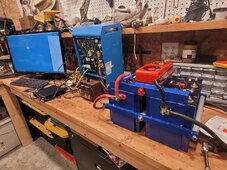I have read somewhere that we can expect better longevity (the difference between 4K and 6k cycles) by more optimal clamping arrangements.
I have read that too, and it puzzled me.
If the cells are tightly constrained, and the internal gas pressure goes up and down, and nothing is really lost, the gas just condenses back into liquid electrolyte in normal operation.
Now if a physically unconstrained cell has permanently bloated, what has changed that reduces the life cycles by so much ?
Still nothing is lost, and chemically nothing should be any different to a skinny clamped cell.
Then the thought occurred to me. A swollen cell will have an increased internal volume, and the level of the liquid electrolyte will be lowered.
That may be the reason for the reduction in life cycles. Its the only thing that I can see that has changed compared to a non swollen cell.
It may even be possible to force slightly swollen cells back into their original shape by clamping. If a cell case can be permanently deformed in the outward direction, it may very well be deformed back to the original shape without any subsequent damage or reduction of life cycles.
This is all just a hypothesis, but its an interesting idea, and the only reason I can see why unclamped cells may have a shorter life.
Over time, normal cycling gas pressure may tend to stretch the cell casing, which leads to a lower electrolyte level shortening its life.
So it may all come back to preventing natural long term swelling. The method is probably less important than achieving the desired result of maintaining the electrolyte level at its original design height, and that might be a lot more critical than we realise.
I have also read that installing cells in orientations other than straight up vertical is not recommended, as some of the pouches, or parts of a pouch can become high and dry, reducing both capacity and lifetime.



